69 Four Storey Agriculture along the Mozambican Coast.
Rick Bein
Four Storey Agriculture along the Mozambican Coast
F.L. (Rick) Bein and Christopher Hill
Abstract
A system of agro-forestry prevails on the sandy soils on ancient raised dunes in coastal Inhambane, Mozambique. We have given the name “Four Storey Agriculture” to this system as it captures the essential features involving different vertical levels of cultivation. Because of the low fertility of the ancient sand dunes the Portuguese colonial masters allowed most of this land to remain with the local population who continued to make it productive. No chemicals can be afforded by the subsistence farmers who must rely on the natural ecological controls. High biodiversity of crops and native species have reduced fertility loss, risk of erosion and pest and disease problems which would have been encouraged by systems of monoculture. Multilevel poly-culture includes over thirty different crops together with local tree species that synergistically interact to support one another to produce a sustainable chemical and fossil fuel free system. The population density in 2000 was over 67 persons per square kilometer.
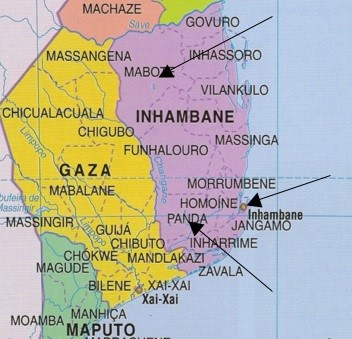 Inhambane Province and surrounding districts of Mozambique. Map from National Archives of Mozambique 2006
Inhambane Province and surrounding districts of Mozambique. Map from National Archives of Mozambique 2006
Introduction
“Four storey agriculture” is the label for the system of agro-forestry that dominates the coastal area of Inhambane Province of Mozambique This system of land use involves the cultivation or preservation of many useful plants growing to different heights (Figure 1). This diverse mix of at least thirty crops includes plants with different life cycles, and those that grow in different environmental micro-zones. Total crop production is increased by dispersing the energy of the strong tropical sun vertically as well as horizontally. A mixture of crops and trees are grown in small family holdings, called machambas, of less than 3 hectares. Coconut trees occupy the top (fourth level) of the agricultural canopy. Fruit trees, including citrus and native occupy the third level. Papaya and bananas are inserted along with the maize to make up the second level. The first level (on the ground) contains vegetables such as beans, tomatoes, greens, sweet potatoes and many more. Since there is no cold season the crops grow throughout the year. Harvesting can occur at any time providing food when needed.

Figure 1. Massinga Administrative Post in the District of Massinga, Province of Inhambane, Mozambique
Massinga, just north of the Topic of Capricorn, is in the transition zone between a tropical and subtropical climate with high rainfall influenced by the warm Argulhas Current along the coast. Although rain can occur throughout the year, there is a main hot rainy season from October to March and another lighter, cool rainy season during July and August. Rainfall is heaviest along the coast yielding over 800 mm (36 inches) per year but diminishes rapidly inland (Figure 2). Average temperature ranges from 19 to 32 degrees Celsius.

Figure 2. Coastal Inhambane receives adequate rainfall to support agriculture.
Because of the high rainfall the tropical forest zone extends throughout southern coastal Mozambique. The Bantu peoples migrating southwards entered this area nearly 2000 years ago brought with them iron working, livestock rearing and sedentary agriculture. The production of charcoal for iron production and the clearing of land for agriculture have dramatically modified the forest. The agro-forestry ecosystem that remains is the result of major human modifications, but has also retained useful trees from the original forests.
Various crops appear at different heights in this agro-forestry ecosystem. The system has many layers, but can be reduced to four dominant ones as described below:
The top level or the fourth storey is occupied by well-spaced coconut palms. These palms when fully grown generally protrude above any other trees. They spread from the coast covering all the area except for permanent wetlands. Most of the coconut palms are residuals from plantations developed during the colonial period.
The third storey includes introduced domestic trees such as cashew, citrus and mango combined with many native wild trees and bushes. Generally the native species are useful species providing the population with many different products including fruit, material for construction or artifacts, fiber, medicines and firewood. This layer ranges in height with some trees, such as the Mango and the indigenous waterberry, almost as high as the coconuts to others such as the citrus, and guava that only reach 3 meters.
The second storey is occupied by short lived crops that grow upright off the ground and includes cassava, corn and sorghum.
The first storey or ground level and includes peanuts, cow-peas, pumpkins, wild invasive ground cover such as cacana (Cucurbitaceous) Momordica balsamina and a variety of vegetables. The local people have developed ways to add the cacana to their meals.
We compare the four story agriculture with the natural forest, a multi-storied natural environment. Our designation is keyed on the presence of the coconuts in this area one of the two main traditional zones of coconut palms in Mozambique (Figure 3).
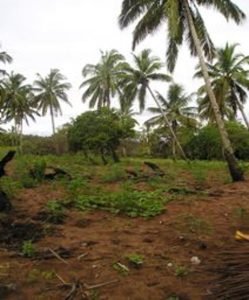
Figure 3: Four storey agriculture starts with the coconut palms that can be seen towering over the fruit trees, which in turn partially shade the cassava plants. The emerging cowpeas capture the remaining sun light that reaches the ground. Many other plants are interspersed in small quantities including those serving medicinal and ornamental purposes.
Crop cycles
Plant life cycles and environmental micro-zones also add agricultural diversity to this high precipitation coastal area. Plant life cycles vary as crops mature through out the year. Some crops like cassava (Figure 4), papaya, bananas and coconuts can be harvested at any time during the year while the annual crops and tree fruits must be collected at the end of specific seasons.
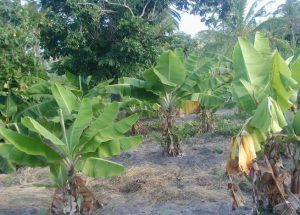
Figure 4: Papaya, bananas and coconuts have no season can be harvested at any time during the year.
The life span of the different crops (Table 1) offers another element of diversity as some like the coconut live for decades while others only a few months. With crops grown in level one, rotations occur starting with plowing to start a two or three year cycle where maize, legumes and vegetables are grown together with pineapple and cassava. Once the maize has matured its leaves are harvested to allow more sunlight to reach the lower and slower growing plants. The cobs may be left on the maize stalks until they are needed for food. The lower growing plants many of which have been climbing on the maize stalks, now surge upward to claim the sunlight. In time those are harvested allowing opportunity for the slower growing crops of cassava and sugar cane to take over the canopy.
| Cycle Time | Crops |
| Long | Palms and Fruit Trees |
| Medium | Bananas and Papaya |
| One – two year | Cassava, Pineapple, Sugar Cane |
| Annual | Maize, Cow-pea, Peanuts, Vegetables |
Table 1. Crop life cycles the four storey agriculture Inhambane, Mozambique
Physical environmental zones
The physical environment of the Massinga coastal area offers three different micro-environments. These three distinct habitats occupy the immediate study area: the beach, deep ancient sand dunes that extend for many kilometers inland and the wetlands that emerge in low areas between the ancient dunes. These topographic habitats are described in the following outline.
Beach
The beach is the active natural system dynamically controlled by waves, currents, storms and winds. In terms of agricultural land use it is limited to few crops cultivated on recently formed sand dunes adjacent to the ancient dunes. For practical purposes this zone is not considered part of the study.
Ancient sand dunes
The ancient sand dunes were formed during prior geologic periods when the ocean encroached further inland. It is also possible that the gradual uplift of the African Plateau raised the coastal formations and stranded the dunes well above the present ocean level. Much of Mozambique resides on this coastal platform of elevated sand. With respect to land use it is on these sands exceeding 100 meters in depth where most of the four storey agriculture takes place.
Wetlands
Wetlands include streams, lakes and low lying poorly drained areas between the dunes. The better drained parts of these humid lands, though small in area, are highly prized for their year around moisture content that support water needy crops.
Environmental Micro-Zones
In the above description of the physical environmental zones, we find that the ancient sand dunes and the partially drained wetlands are incorporated into four storey agriculture. The machamba (where the most intensive short term crops are grown) can be located on either of these environments. But of equal importance is the area around the homestead (called a quintal[2] ). These three micro environmental zones contribute to the system, each containing its own diversity and variety of crops. See Table 2. Most of the machambas are located on ancient well drained sand that have limited fertility but sustains a diverse array of crops dominated by coconuts mixed with other crops and some other trees. While in between the ancient sand dunes are small low lying humid areas where water accumulates and supports a somewhat different array of crops (Figure 5). Here bananas, sugar cane and horticulture thrive.
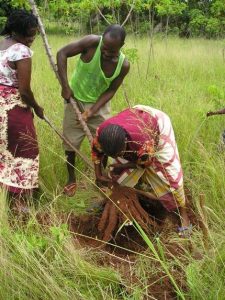
Figure 5: Humid machamba showing the harvest of cassava.
The dispersed rural settlement pattern that prevails in coastal Inhambane Province fosters the quintal micro environment that allows for a highly concentrated mix of crops. Around the quintal many different useful plants are cultivated in small quantities (Figure 6). Here spices, ornamental and medicinal plants are grown for immediate use. Also, this is where the farmer will grow the more recent plant acquisitions with which she can maintain regular contact. Because of the proximity to the dwellings, it is easier to attend to the needs of plants. Hand irrigation and the application of recyclable household wastes help to sustain these more delicate plants. Normally the quintal is located on the ancient sand deposits, but contains all the crops grown in both the humid and upland areas.
Environment Type |
Upland | Humid | Quintal |
| Condition | ancient dunes | wetland borders | regular care |
| Crops: | coconut trees | Bananas | bananas |
| fruit trees | fruit trees | fruit trees | |
| wild fruit trees | wild fruit trees | wild fruit trees | |
| other useful wild trees | |||
| cassava | sugar cane | sugar cane | |
| maize | sweet potato | sweet potato | |
| Cow-pea | horticulture | horticulture | |
| peanuts | medicinal plants | ||
| squash | coconut trees | ||
| tomatoes | spices |
Table 2. Products of four storey agriculture by micro-environmental zone along the high rainfall coast of Inhambane, Mozambique.

Figure 6: the biodiversity around the quintal is very high because the plants receive regular attention. Here the indigenous Waterberry tree (Syzygium cordatum) provides fruits that are eaten but also made into alcohol.
Tropical Biodiversity
Bio-diversity is greater in the humid tropics because environmental limitations are less than in the temperate regions. Winter kill does not exist and prolonged drought is infrequent. As a result the natural biodiversity of pests like weeds, insects and diseases are much more prevalent and are extremely difficult and expensive to eliminate in the tropics. However, the natural predators of the weeds, pests and diseases are also more diverse and react to control their numbers. The higher biodiversity reduces pest and disease problems which would have been invited by monoculture. It is the biodiversity itself that controls (not eliminates) pests. A study done by K.S. Powel[3] in Papua New Guinea in 1998 shows that insect pest species are outnumbered by 50% by their insect predator species. The conditions here are similar in the Massinga District machambas where there is no chemical or manual control of insects and the biodiversity itself helps to keep pest populations in check. Fallow periods in the two lower stories, also help control for pests and diseases while effectively providing space for a few livestock to graze. In general crop biodiversity minimizes the risk of insect infestations and plant diseases while the crop mix does not deplete the weak sandy soils as rapidly as monoculture.
Land use
As stated above the four storey agriculture is typified by coconut trees spaced from 10 -15 meters apart with other useful trees dispersed below. The crops of the two lower levels are rotated between fallow periods. Here controlled burns are normally used to clear the low level under- story vegetation while carefully protecting the existing trees and any new useful wild trees that might have grown during the fallow period. The fallow cycle normally varies from three to fifteen years.
Many wild African trees species grow spontaneously in the machamba and fallow areas and those that have utility are allowed to remain. Most of these are fruit trees, but others are used for fiber, construction or medical purposes. There are over eighty different useful plants growing in the study area. This includes twenty four identified useful wild fruit tree species[4].
The different crops support each other with nutrients. Particularly important are the legumes cow-peas and peanuts and a number of common trees that deposit nitrogen in the nutrient starved soil. Taller crops like trees, cassava and maize support the climbing plants. Farmers seek shady spots to plant sensitive vegetables. Even though the coconut trees take a lot of water out of the soil, their shade and the shade of the fruit trees reduces evaporation and makes more moisture available for the lower growing crops. The ground cover crops reduce the loss of humidity in the soil, reduce the quantity of weeds and reduce soil erosion.
Using air photography provided by “Google Earth”[5] over the internet, the land use can be clearly demarcated when the high resolution imagery is enlarged. Coconuts palms can be counted groves of bananas and other fruit trees demarcated, and full grown cassava plantations recognized. It general area of land use such as annual crops and fallow land can be clearly identified. We have verified that what we see from above is truly what we see on the ground. See Figure 7.
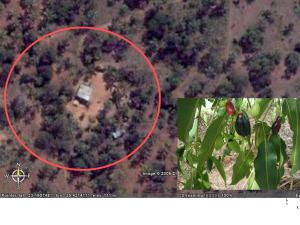
Figure 7: Diversity of cropping can be seen in this Google Earth image. The quintal in the center of the circle is surrounded by many types of wild domesticated trees species.
Comparison with shifting cultivation
The four storey agriculture must be clearly differentiated from the practice of slash and burn shifting cultivation. Typically slash and burn tactics indiscriminately destroys the forest to make way for crops. Cropping continues on the same land for 1-3 years followed by forest fallows that may last decades before they are cut and burned again. The sustainable human population in shifting cultivation is very low and clearings are dispersed over wide expanses of forested land. Hunting and gathering also contributes to sustain the farmers. As population pressure increases the forest fallow period becomes shorter and shorter until the cultivated land is greater than the fallow land.[6] New strategies evolve that the farmers find necessary to over come increasing pest problems, depletion of soils and reduction of available land.
Our study area is part of the relative densely populated coastal zone of Mozambique and occupies the coastal part of Massinga Post in Massinga District. In 1997 the population of Massinga post was 138, 871 with an arithmetic density of about 67 persons per square kilometer.[7] The actually population density of the study area is higher that this because much of the administrative post includes undesirable land further from the coast.
In the coastal zone of Inhambane, the four storey agriculture has evolved with the Bantu people whose Iron Age capabilities allowed them to alter the forest. As the population increased, the forest became “at risk” and modifications were made to compensate for the loss of the hunting and gathering that supplemented their lively hoods. A deliberate strategy has developed of selectively maintaining forest plants. Fire became used in a limited way to clear the ground below the useful trees. Essentially this strategy involved limited or controlled burning and the preservation of useful wild plant species with in or between the cultivated areas. Within the memory of the living people, large wild life has disappeared.
Fallow
The fallow land in the four story agriculture is still productive. Fallow refers to land where the lower two stories, the annual and semi-annual crops are not grown. On the fallow, the coconuts and useful trees continue to produce harvests while tethered livestock graze the grasses and shrubs that grow up naturally. Un-harvested cassava plants remain amongst the new bushy growth. “Grass fallow” characterizes the land in the early years but as more herbaceous and woody plants grow it is frequently called “bush fallow”.[8]
Land may remain fallow from 2 to 18 years. With each additional year, the vegetation on the fallow area becomes denser and more diverse, eventually becoming impassable by humans. Many wild plants grow to maturity and wild trees join the canopy of coconuts and other useful trees. Climbing plants grow up into the trees seeking a piece of the sunlight. Plants and animals that would not be allowed to exist where the annual crops are cultivated can now flourish. Some of our respondents say that many of fruits that die in the controlled burns will only survive where the fallow period is long. The biodiversity is highest in the older fallow areas and have become a store houses of fruits, medicines and plants used for fiber, glue and construction material. Traditional healers often maintain exclusive areas of medicinal and sacred plants that extend the fallow into many decades (Figure 8)
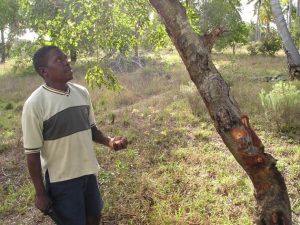
Figure 8: Wild African trees with medicinal value are maintained in the machambas. This local herbalist describes the qualities of this tree.
There seems to be no certain length of time that a piece of land will be allowed to remain fallow. The land closest to the quintal will experience shorter fallows. In some cases an area has been fallow for a long time because its owners have gone away or the heirs have not take the same interests in farming as their parents. In many cases the coconuts go unattended and the neighbors end up harvesting the copra.
Our respondents tell us that there are small patches of long fallow that have emerged with lots of wild fruits and because these have become favorite areas for the children. Many of the wild fruits eaten are produced on smaller trees or vines that grow quickly after the burning and clearing takes place. Likewise when there is a vigorous growth of useful plants in a fallow area the farmers will clear around them and be careful not to burn them when they are preparing machambas. An example of such a wild tree is the Mopani (colophospernum mopane) which has an unusual benefit of attracting mopane worms (imbrasia belina,) which are considered a delicacy by the locals.
Another respondent says that it is a lot of work to clear an area left in fallow for a long time, but it is worth it because the dead leaves and wood that has fallen on the ground acts as fertilizer for new crops. She adds that the accumulated wood is good for building material and for fuel. By allowing the fallow to continue for more years she could benefit from the harvest of this wood.
Respondents say that they often will allow the fallow go longer than 2-3 years when they use it to pasture pigs, cows, goats and donkeys, but only when it is a good distance form the house. The closer fields will be returned to annual crops as soon as possible.
We have observed many of the fallow areas and have noted many differences in appearance. In some of the older fallows the vegetation has grown up to the density described in previous paragraphs while others have become dominated by one species of tree. At one such site we found a large number of Tzondzo (Fabaceae) Brachystegia spiciformis trees, useful for its bark to make string and canoes. At this particular site these trees reached their full growth of 6-8 meters but did not create a closed canopy. Sunlight reached the ground in many places and the growth of other species was scant and stunted. The coconut trees in the area only had few coconuts. It is hard to imagine that this fallow area had not experienced human intervention. Yet there is much to understand about the nature of the Tzondzo tree with regard to its specific biology and chemistry.
Another long fallow site that we visited contained healthy coconuts with a large number of waterberry trees locally known as ticori trees (Myrtaceae Syzygium cordatum, (See fruit in Figure 7 above.) It would be expected that as the fallow progressed the biodiversity would increase. The frequency of the ticori contradicts this. The ticori tree grows wild and survives controlled burning and is encouraged by the farmers because of its delicious fruits and for its high quality of distilled alcohol. It may be that the ticori trees had been allowed to accumulate over successive clearing times and fallow times, so that there dominance in this particular fallow was notable.
One site has been fallow 22 years and contains no coconuts. Its owner had no interest in farming the area. Nearby residents say that the area had been a community horticulture garden before it was abandoned. Today it represents a rare preserve of vegetation that is proceeding into more advanced stages of ecological succession.
The fallow periods are diminishing in the coastal area of Inhambane. This is recognizable by the increasing shortages of construction wood which would be provided in the long fallow areas. There is an increasing demand for construction wood for housing which is now coming from the dry interior of the province.
Environmental and cultural limitations
The four storey agriculture developed from the natural forest and maintained much of its biodiversity. The useful forest plants have been retained, while over an extended period new crops have been introduced. Natural forces tend to fill as many ecological niches as possible, while human intervention tends to encourage only useful species. The principal environmental limitations of biodiversity are the dry season, variability of rainfall, occasional controlled fires, culturally selective elimination of non-useful wild plants, limited animal grazing and cultivation of annual crops.
The infertile soils which might be considered a limitation for monoculture is less of a factor in the polyculture of four storey agriculture. Three soil samples were taken in July 2006 in three locations (Table 3) in the study area.[9] The first was taken in the intensively planted area in the Quintal, the second was taken in the area of bush fallow where the soil had been un-tilled for the longest time of 22 years and the third was taken in area of grass fallow becoming bush fallow. All of the pH levels were slightly acidic with low levels of phosphorus and potassium. Nitrogen although low, was in the normal range expected for sandy soils.
Development for survival
This survival strategy system has evolved over the last 2000 years beginning with the immigration of Bantu people who have added to their native crops by including useful exotic plants whenever they became adaptively available. Only the cow peas, sorghum, millet, okra, bambara ground nut, squash, water melon, and yam originate in Africa. Introductions came first from Asia and later from America. All the domesticated fruit trees are introduced species although there a many species of edible wild fruit trees. A few native African fruit tree species are becoming domesticated.
Historically four storey agriculture offered a system that reduced risks so farmers could provide for themselves when crops failed. It helped them survive many years of political instability and an eighteen year long civil war. The diversity of annual crops and fruits distributed food harvesting over a greater period of the year. The diversity of foods offered a self-sufficient nutritious diet. If there was a drought, some crops survived better than others. See Table 4. The system offered a conservative strategy that has served them time and time again.
Coconuts (cocos nucifera) are the key cash crop, but a wide array of other crops are also sold. Alcohol distilled from fermented fruits and sugar cane is also a major source of income. Most crops are grown for home consumption. Coconut products also a major item of home consumption. Coconut milk is a key component of many dishes consumed by the local population. Other crops, like peanuts may be grown for both sale and home consumption particularly when there is a surplus. See Table 4.
| Commercial | Own Consumption |
| copra and coconuts | coconut products |
| alcohol distilled from fruit | maize |
| Peanuts | peanuts |
| artisan products | Cow peas |
| citrus, mango, guava, papaya fruits | fruits (cultivated and wild) |
| firewood and charcoal | cassava |
| construction material | sorghum |
| livestock | products of the Natal Mahogany |
| cashew nuts | sweet potatoes |
| meat | meat |
| vegetables | |
| mopane worms |
Table 4. The Products of Four Storey Agriculture, Massinga, Mozambique
The Coconut Zone
Coconuts are traditionally grown in the coastal zone of Inhambane. The early Portuguese arriving in 16 century reported the presence of the coconut trade at the city of Inhambane[10]. . The relative high rainfall and the tolerance to the sandy soils made it an ideal habitat for the coconut palm. More coconut plantations were encouraged for the export of copra. Today Inhambane contains the largest percentage of farms with coconuts than any other province in Mozambique[11]. See Figure 9. The area of coconuts is currently spreading inland and southward.
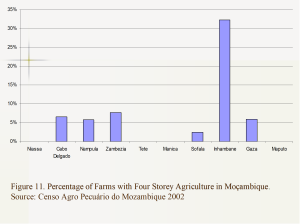
Figure 9: Percentage of Farms with Four Story Agriculture in Mozambique Source: Censo Agro-pecuário. 2000. Jointly published by Ministério da Agricultura and Instituto Nacional de Estatistica, Moçambique.[12]
There has recently been a revival of the copra trade, but this trade still only buys a small share of the total farm production. Whatever the case, the local population continued using the coconuts and the palms in their traditional manner as they provided a number of other products that the community needed. See Table 5.
| Coconut | Other parts of the tree |
| copra | palm wine |
| cooking oil and soap | wood |
| coconut milk | fronds for roof and walls |
| coconut water | wall braces |
| ladles | brooms |
| husks for: | water container for still |
| cushions | pins |
| fuel | |
| rope |
Table 5. Coconut tree uses in Massinga, Inhambane, Mozambique.
Citrus and mangos has been a long time partner in the four storey system. Tangerines were added in the 1930’s.[13] The copra commerce declined seriously during the civil war but has experienced some recovery recently.
There are two major coconut zones in Mozambique, Zambezi and Inhambane. The patterns of cultivation of these two zones are quite different. Zambezi Province consists mainly of large scale plantations of improved varieties, whereas cultivation in Inhambane is smallholder agriculture growing traditional varieties. Today there is a major problem with the improved varieties as huge areas of palms are dying of disease.
Use of “Google Earth” for Analyzing Land Use
The use Google Earth has made it possible to see houses and trees in great detail. The detail is sufficient to be able to clearly identify coconut palms. Even where there is dense tree cover palms can be seen clearly when they are tall enough to stand out above the other trees. It has also been possible to clearly locate other areas of vegetation including areas of annual cultivation even when this is under partial tree cover. It is also possible to clearly identify areas of long fallow where there is dense scrub vegetation under tall trees.
A study area of 80 square kilometers has been identified. This area is bounded on the east by the Indian Ocean, on the south be a red sand road, on the west by the national highway and a minor highway leading to the village of Rio das Pedras and on the north by the wet margins and swamp of the river Rio das Pedras. The interest is to use analytic software to attempt to make an analysis of the entire vegetation cover of the study area and also identify the extent to which coconut palms are growing west of the area.
The following classification of land use can be identified
River and swamp lands
- Cultivated areas with all year round humid soils adjoining rivers and swamps with little tree cover generally containing either 1.) bananas or 2.) sugar cane
- Homesteads clear of vegetation often with a surround of dense trees
- Cultivated fields normally with some light tree cover
- Bush Fallow – Dense areas of trees and scrub vegetation
- Areas that are under short term fallow
The coconuts are clearly identifiable by shape and also appear to have a different color from other trees. It is therefore also possible to distinguish areas in which most or all the trees are coconut palms and areas where the coconut palms are mixed with other trees.
Determining the Limits of the area of Coconut Palms
The study area is for the most part an area of coconut palms apart from the wet zones. West of this area the density of coconut palms declines. Whereas, in the study area coconuts are generally spread throughout the countryside but to the west coconut palms tend to be found in distinct clusters associated with individual holdings. As coconuts are not naturally dispersed on land their presence indicates deliberate planting, so they tend to be grown in organized rows or clusters.
- Concentrated coconut palm zone
- Intermediate zone where coconuts palms are found in reasonable quantities normally in clusters
- Rare zone where there are few palms
- Non coconut zone.
More general estimate of coconut palms
The study area is an area of concentrated coconut palms. Coconuts are found along the coastal area throughout the province of Inhambane. The concentrated zone occurs from Massinga district south through most of the other coastal districts of the province. We would like to provide a indication of the complete area of coconut palms with possibly a classification into the concentrated area and the intermediate zone.
The Importance of livestock
Small animals and poultry including goats, pigs and chickens contribute significantly to the diet of the people and are also sold to bring income. However there have been serious disease problems. Newcastle Disease and chicken influenza are annual events but can be preventable by vaccination distribution. Pestiswina Africana periodically almost destroys the entire pig population. There are also diseases that attack the goats. These diseases serious reduce the productivity of the four storey agricultural system.
Traction animals are an important source of power for farming in this system (See Figure 10). Although the numbers of these animals diminished greatly during the long civil war of the 1970s and the 1980s they are recovering their numbers with time. Plowing with oxen and donkeys facilitates the cultivation process with the annual and biannual crops. With out them soil must be tilled by hand hoeing.
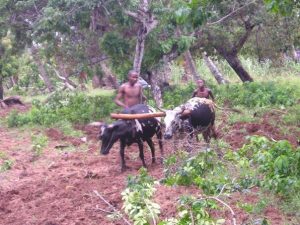
Figure 10: Bullocks being used to plow the soil before planting maize.
The Role of Gender in the Four Story Agriculture
In rural Inhambane there is a ratio of 175 women for every 100 men[14]. In most cases the persons responsible for the machambas are women. There has been a long tradition of men going to work in the mines in South Africa. Remittances sent home contributed significantly to the local economy. Children are important assets to this labor intensive farming. When men are part of the farming process they perform the heavy work like land clearing and plowing. They are also much more likely to engage in non agricultural activities to earn extra inc
The authors interviewed both men and women farmers about their roles. Although some activities are gender specific, many activities are not rigidly defined by gender (Figure 11).

Figure 11: Preparing food for drying is typically the job of women and girls.
Women play more active roles in the agriculture process, but men are also involved. Normally a certain task like carrying produce from the machambas is done by women, but men can be seen doing the same task. Table 6 details gender roles.
| Gender Role | Women | Men | Girls | Boys |
| Grating cassava | x | x | ||
| Selecting seed | x | |||
| Clearing land | x | |||
| Planting | x | x | ||
| Alcohol preparation | x | |||
| Plowing | x | |||
| Hoeing | xx | x | ||
| Drawing water | x | xx | x | |
| Collecting wood | x | x | x | |
| Climbing coconuts trees | xx | x | x | |
| Preparing coconut milk | x | x | ||
| Tapping coconut wine | x | |||
| Fishing from boats | x | |||
| Hunting | x | |||
| Trapping small animals | xx | x | ||
| Food preparation | x | x | x | x |
| Cooking | x | x | ||
| Feeding chickens | x | x | ||
| Feeding pigs | x | x | ||
| Care for cattle | x | x | ||
| Care for goats | x | x | x | |
| Preparing Cashews | x | |||
| Collecting Cashews | x | x | x | x |
| Cutting sugar cane | x | x | ||
| Weaving palm fronds. | x | x | ||
| Weaving mats | x | x | ||
| Building houses | x | x | ||
| Making charcoal | x | |||
| Cutting construction cane | x | x | ||
| Child care | x | x | ||
| Treating Illness | x | x | ||
| Weeding | xx | x | ||
| Carrying Harvest | x | x |
Table 6. Gender roles in Sota, Massinga District, Inhambane,
Mozambique. Adolescents are included as adults rather than children. xx = more likely. Source Maria Rosa Guambe[16
Conservation of Labor in Four Storey Agriculture
In the machambas of coastal area of Massinga there is never a time when there is nothing to do. Because of the diversity of crops and protected useful wild species, many types of activities create a high demand for human labor. Animal traction is used by some families but is the only power source used. Only the tasks that are essential to the farming process are performed leaving little time for the appearance of neatness. Jobs like clearing large dead trees or removing termite mounds are left undone because they have no priority.
Controlled burning is undertaken to clear the land. It saves labor that also helps reduce pests. Dead trees may remain for some years while the small controlled burns eat away at the wood. Pieces of the wood are also collected for fuel when necessary.
The normal settlement pattern of this area is dispersed farms rather than centralized villages. This allows the small holders to live permanently on their farm land minimizing the time taken to reach their machambas. Forgoing the safety of a village, living at the work site drastically reduces travel time and results in significant conservation of labor.
Most of the labor in the four story agriculture is involved with the annual and biannual crops and the most potentially demanding task is weeding. By having good ground cover crops like cow peas reduces the need for weeding. Land preparation can be equally arduous particularly if the land being prepared has been fallow a long time. Here the use of controlled burning reduces labor.
Future of Four Story Agriculture
Four storey agriculture offers a highly sustainable system of continuous agriculture which has been existence for at least one thousand years. The highly diverse cropping system enables the successful cultivation of low nutrient sandy soil. The synergistic mixture of over 30 crops compensates for inadequacies of the soil. The different crops support one another as some add nutrients to the soil that the others need, while others seem to deter pests that prey on the former. Where weeds flourish, the people find a way to incorporate them within the system. Weeds and pests are eaten. Weeds like cacana, are made in to salads while pests are cooked to become delicacies.
It is also an environmentally sustainable system that appears to reasonably optimize the uses of natural resources. The non use of fossil fuels in four story agriculture makes the system sustainable in light of the world’s current fuel crisis. Of course the affordability of fossil fuels is beyond the reach of this rural Mozambican region.
The system operates mostly outside the formal economy and the people prevail in what the modern world would call abject poverty yet there is adequate food for local consumption. The system also coexists with high labor migration of men to the Republic of South Africa. Without this remittance income the population would be much poorer and its sustainability threatened.
There is a great potential to increase the income of this system with improved organization and marketing of fruits. At the moment there is great spoilage of fruits for lack of infrastructure. While the annual occurrence of crop surpluses would make it possible to increase farmer income it would also contribute to the economy of Mozambique if infrastructure such as roads, agro-industries and micro financing were available. The marketing and protection of small livestock and poultry could also contribute to the economic well-being of the community as diseases frequently decimate large numbers of livestock and poultry.
References:
Bein, F. L. (Rick) and Christopher Hill. (2009). Four Storey Agriculture in the District of Massinga, Province of Inhambane Along the Mozambican Coast, Journal of Geography, vol. 52, no 4.
Berkes, Fikret. (2008). Routlege, New York.
Boserup, Esther. (1965) The conditions of Agricultural Growth: The economics of Agrarian Change under Population Pressure. Chicago: Aldine Press.
Censo Agro-pecuário. 2000. Jointly published by Ministério da Agricultura and Instituto Nacional de Estatistica, Moçambique.
Google Earth (2006) Virtual Globe Program.
Newitt, Malyn D.D.(1995) A History of Mozambique. London: Husrt & Comapny .
S. Powel. 1997. Biodiversity Inventory of the Kamiali Wildlife Management Area. Edited by F.L. Bein, Papua New Guinea University of Technology, Lei, PNG.
Renciamento Geral da População e Habitação do Mozamibique. 1997. Instituto National de Estatistica do Moçambiaque.
University of Eduardo Mondlane Levantamento da Fauna Bravia e Avaliaçao das Plantas Uteis em Morrungulo, Distrito de Massinga, Provincia de Inhambane, Unpuplished Report Maputo 2003 supplemented by additional field work by the authors
[1] Mozambique resides in Southeast Africa along the Indian Ocean extending 2500 km. along the coast from the border of South Africa at 26º 51’ south 32º 53’ east including borders with Swaziland, South Africa, Zimbabwe, Zambia, Malawi, and Tanzania at 10º 28’ south, 40º 26’ east. It occupies the coastal plane of Africa abutting to the west with the African Plateau. It is approximately twice the size of California and contains 10 provinces and houses 20 million people.
[2] Quintal is the Portuguese term for door yard which in this study includes the residence, surrounding buildings and area of specialized crops.
[3] K. S. Powel. 1997. p 38.
[4] University of Eduardo Mondlane
[5] Google Earth 2006.
[6] Boserup, Ester. pp 75-80.
[7] Renciamento Geral da População e Habitação do Mozamibique.
[8] Boserup, Ester. pp 65 -66
[9] Soil samples taken from the top 50 millimeters included litter layer when present. Analysis was completed by the Soils Laboratory staff at the University Eduardo Mondlane.
[10] Newitt, Malyn, p 29.
[11] Censo Agro-pecuário. 2000.
[12] Ibid
[13] Manuel Zunguzi (elderly resident farmer) private interview. July 2006
[14] Christopher Hill. “Report on Gender in Mozambique”2002 Unpublished
[15] Censo Agro-pecuário. 2000
[16] Maria Rosa Guambe, Resident farmer interview July 2006

